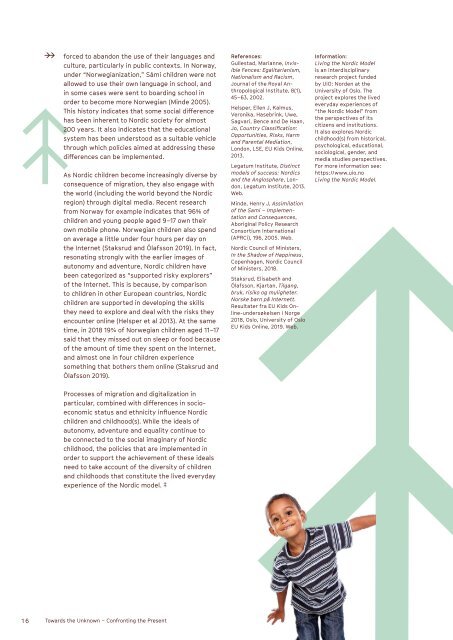ASSITEJ Magazine 2019
This is the annual ASSITEJ magazine, launched during the ASSITEJ Artistic Gathering 2019 in Kristiansand (Norway). It contains high-quality articles on theatre for young audiences from all corners of the world!
This is the annual ASSITEJ magazine, launched during the ASSITEJ Artistic Gathering 2019 in Kristiansand (Norway). It contains high-quality articles on theatre for young audiences from all corners of the world!
Create successful ePaper yourself
Turn your PDF publications into a flip-book with our unique Google optimized e-Paper software.
forced to abandon the use of their languages and<br />
culture, particularly in public contexts. In Norway,<br />
under “Norwegianization,” Sámi children were not<br />
allowed to use their own language in school, and<br />
in some cases were sent to boarding school in<br />
order to become more Norwegian (Minde 2005).<br />
This history indicates that some social difference<br />
has been inherent to Nordic society for almost<br />
200 years. It also indicates that the educational<br />
system has been understood as a suitable vehicle<br />
through which policies aimed at addressing these<br />
differences can be implemented.<br />
As Nordic children become increasingly diverse by<br />
consequence of migration, they also engage with<br />
the world (including the world beyond the Nordic<br />
region) through digital media. Recent research<br />
from Norway for example indicates that 96% of<br />
children and young people aged 9–17 own their<br />
own mobile phone. Norwegian children also spend<br />
on average a little under four hours per day on<br />
the Internet (Staksrud and Ólafsson <strong>2019</strong>). In fact,<br />
resonating strongly with the earlier images of<br />
autonomy and adventure, Nordic children have<br />
been categorized as “supported risky explorers”<br />
of the Internet. This is because, by comparison<br />
to children in other European countries, Nordic<br />
children are supported in developing the skills<br />
they need to explore and deal with the risks they<br />
encounter online (Helsper et al 2013). At the same<br />
time, in 2018 19% of Norwegian children aged 11–17<br />
said that they missed out on sleep or food because<br />
of the amount of time they spent on the Internet,<br />
and almost one in four children experience<br />
something that bothers them online (Staksrud and<br />
Ólafsson <strong>2019</strong>).<br />
References:<br />
Gullestad, Marianne, Invisible<br />
Fences: Egalitarianism,<br />
Nationalism and Racism,<br />
Journal of the Royal Anthropological<br />
Institute, 8(1),<br />
45–63, 2002.<br />
Helsper, Ellen J, Kalmus,<br />
Veronika, Hasebrink, Uwe,<br />
Sagvari, Bence and De Haan,<br />
Jo, Country Classification:<br />
Opportunities, Risks, Harm<br />
and Parental Mediation,<br />
London, LSE, EU Kids Online,<br />
2013.<br />
Legatum Institute, Distinct<br />
models of success: Nordics<br />
and the Anglosphere, London,<br />
Legatum Institute, 2013.<br />
Web.<br />
Minde, Henry J, Assimilation<br />
of the Sami – Implementation<br />
and Consequences,<br />
Aboriginal Policy Research<br />
Consortium International<br />
(APRCi), 196, 2005. Web.<br />
Nordic Council of Ministers,<br />
In the Shadow of Happiness,<br />
Copenhagen, Nordic Council<br />
of Ministers, 2018.<br />
Staksrud, Elisabeth and<br />
Ólafsson, Kjartan, Tilgang,<br />
bruk, risiko og muligheter.<br />
Norske barn på Internett.<br />
Resultater fra EU Kids Online-undersøkelsen<br />
i Norge<br />
2018, Oslo, University of Oslo<br />
EU Kids Online, <strong>2019</strong>. Web.<br />
Information:<br />
Living the Nordic Model<br />
is an interdisciplinary<br />
research project funded<br />
by UiO: Norden at the<br />
University of Oslo. The<br />
project explores the lived<br />
everyday experiences of<br />
“the Nordic Model” from<br />
the perspectives of its<br />
citizens and institutions.<br />
It also explores Nordic<br />
childhood(s) from historical,<br />
psychological, educational,<br />
sociological, gender, and<br />
media studies perspectives.<br />
For more information see:<br />
https://www.uio.no<br />
Living the Nordic Model.<br />
Processes of migration and digitalization in<br />
particular, combined with differences in socioeconomic<br />
status and ethnicity influence Nordic<br />
children and childhood(s). While the ideals of<br />
autonomy, adventure and equality continue to<br />
be connected to the social imaginary of Nordic<br />
childhood, the policies that are implemented in<br />
order to support the achievement of these ideals<br />
need to take account of the diversity of children<br />
and childhoods that constitute the lived everyday<br />
experience of the Nordic model.<br />
16 Towards the Unknown – Confronting the Present



